What is aging skin?
As the body ages, the appearance and characteristics of the skin alter.Ageing is accelerated in those areas exposed to sunlight, a process known as photoag(e)ing. Photoageing is due to damage caused by short wavelength ultraviolet radiation (UVB) injury to the outside layers of the skin (epidermis), longer wavelength ultraviolet radiation (UVA) to the middle layers (dermis) and infra-red A radiation to the deeper dermis and subcutaneous tissue. Cell damage occurs because of the formation of reactive oxygen species.
Ageing changes are particularly apparent on the face, and occur at an early age in New Zealanders who have spent much time outdoors, especially if they are fair skinned (skin phototypes I and II).
Ageing of the skin is also accelerated by smoking - long term smokers have more facial lines than non-smokers of the same age, and tend to have a yellowish sallow complexion. Smoking may also increase the chance of skin cancers.
Photoageing changes
Photoageing or sun damage results in fine lines and wrinkles, discolouration and textural changes. The epidermis becomes thinner so the skin easily blisters, tears and grazes. The skin feels dry because it is less able to hold onto water. Yellow thickened bumps (solar elastosis or heliosis) are due to tangled masses of damaged elastin protein in the dermis. There is also increased dermal collagen due to scarring from repeated inflammation (sunburn, acne and other skin diseases). The thick dermis loses elasticity and is weaker than normal.Overactivity of tanning cells (melanocytes) results in blotchy pigmentation with brown freckles, solar lentigines and white marks (idiopathic guttate hypomelanosis).
There may also be dilated small blood vessels (telangiectases), cherry angiomas and bruises (senile purpura).
The hair follicles may plug up with dead skin and broken-down cellular proteins, resulting in blackheads & whiteheads (solar comedones) and shiny brown gel-filled bumps (colloid milia).
Aging skin is also very prone to develop harmless brown warty lesions (seborrhoeic keratoses).
Skin cancer
Ultraviolet radiation in sunlight results in oxidation, ionisation and genetic changes to cellular components including DNA (deoxyribonucleic acid). It also has profound effects on the skin immune system. This means aging skin is prone to skin cancer. You should regularly check your skin for lesions requiring treatment if you are over 40, fair skinned, ever badly sunburned &/or if you work outdoors. Consult your doctor if you have any growing lumps, sores that don't heal, new spots or just for a general check.Solar keratoses (also known as actinic keratoses) are tender red dry spots found most often on the temples, bridge of nose, cheeks and upper lip. They are common on the backs of the hands. Solar keratoses are msot often removed by cryotherapy (freezing with liquid nitrogen).
Basal Cell Carcinoma (BCC) is the commonest type of skin cancer. A slowly growing flesh-coloured lump may develop into a sore that won't heal. It is often located on the forehead or side of the nose. On the trunk it often takes the form of a slowly enlarging red dry patch. BCCs are most often removed by minor surgery.
Bowen disease, (in-situ squamous cell carcinoma) presents as multiple red slowly-growing crusted patches, most often on the lower legs.
Squamous Cell Carcinoma (SCC) may grow rapidly, forming a tender crusting lump. They are found on the exposed areas, especially ears, lips, hands and lower legs and usually grow from a solar keratosis. Surgical excision is the usual method of treatment.
Melanoma is the least common but most dangerous skin cancer, and may occur in young adults as well as the elderly. It takes the form of a growing mole or freckle with an unusual appearance. If diagnosed and removed by a simple operation at an early stage, it is usually cured.
Photoageing classification
The degree of sun damage has been classified by Glogau:Mild (age 28-35 years): Few wrinkles, no keratoses, requires little or no make-up
Moderate (age 35-50 years): Early wrinkling, sallow complexion with early actinic keratoses, requires little makeup
Advanced (age 50-60 years): Persistent wrinkling, discoloration of the skin with telangiectases and actinic keratoses, always wears makeup
Severe (age 65-70 years): Severe wrinkling, photoaging, gravitational and dynamic forces affecting skin, actinic keratoses with or without skin cancer, wears makeup with poor coverage

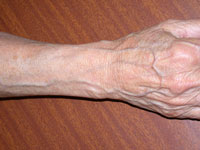
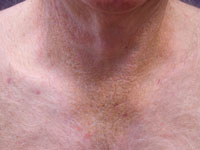
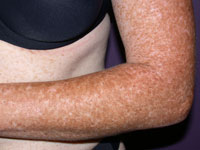
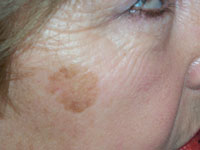
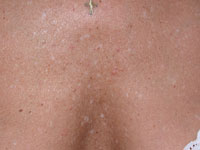
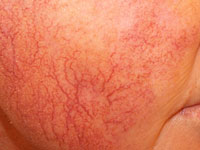
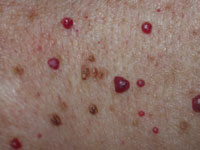
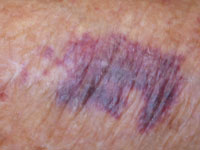
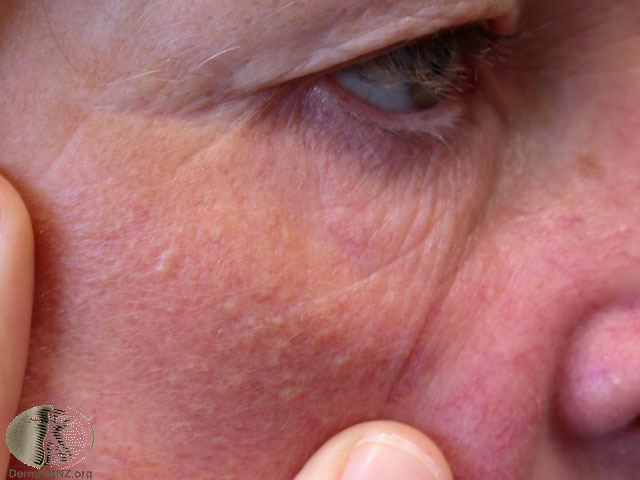
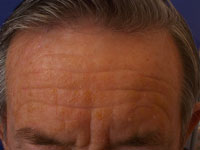
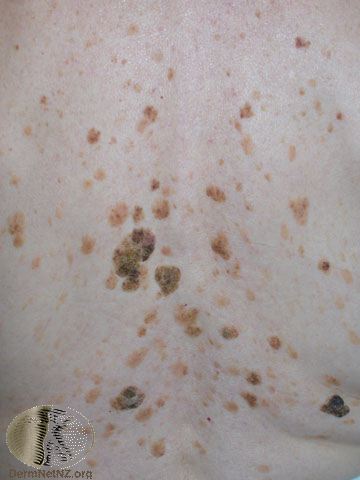
Care of ageing skin
Sun protection of the face is always important, but particularly in summer. Avoid outdoor activities during the middle of the day.
Do not smoke. Smoking increases facial lines and wrinkles, delays skin healing and is bad for you. Exercise is good for the skin as well as for your general health.
Sunscreens should be applied daily to the face, more often when outdoors. Cover up when outside - sunscreens may protect against UVB but they are not effective against longer wavelengths.
Moisturisers can be used to smooth the skin if it is dry and flaky.
Take plenty of exercise - active people appear younger. Eat a healthy diet with plenty of fruit and vegetables to provide natural antioxidants.
Consider treatments that rejuvenate photoaged skin. Consult a dermatologist or plastic surgeon for expert advice.
Alpha-hydroxy acids, vitamin-C, lipoic acid or retinoid creams applied regularly long term may reduce the number of fine wrinkles and fade blotchy pigmentation. In postmenopausal women a cream containing progesterone may improve skin elasticity and firmness.
Collagen, hyaluronic acid, polytetrafluoroethylene implants and fat grafts can disguise facial expression lines.
Botulinum toxin (BOTOX® or Dysport®) injections are used to reduce frowning and lessen deep furrows.
Resurfacing procedures such as dermabrasion, chemical peels, fractional laser treatment and laser resurfacing remove the top layer of damaged skin, which is replaced by new healthy cells.
Vascular laser treatment can reduce unsightly facial veins and angiomas.
Thread veins on the legs can be treated by injections (sclerotherapy).
Cosmetic surgery is required to remove redundant sagging skin, such as a blepharoplasty for baggy eyelids and a face lift to tighten the jowls.
